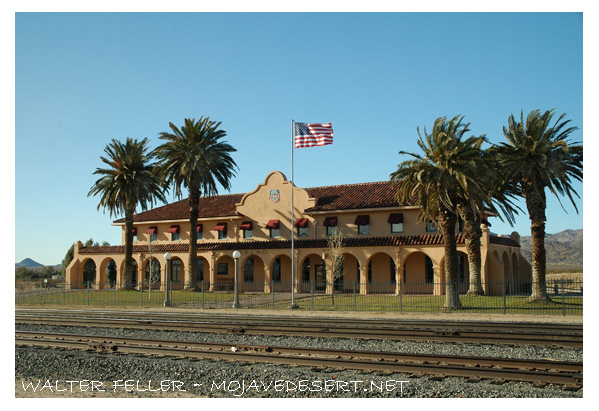
Kelso Depot, also known as the Kelso Depot Visitor Center, is a historic railroad station in the Mojave Desert within the Mojave National Preserve in California. It serves as a significant historical landmark, offering insights into the region’s railroad history and the broader story of the American West.
History and Significance
Construction and Early Years
The Los Angeles and Salt Lake Railroad, later absorbed by the Union Pacific Railroad, constructed Kelso Depot in 1923. The depot was strategically located at Kelso, a small community that sprang up primarily to serve the railroad and the nearby mining operations. The location was chosen because it provided a crucial water stop for steam locomotives and a place to house “helper” engines needed to assist trains over the steep grades of Cima Hill.
Architectural Style
The depot was built in the Spanish Mission Revival style, popular in the southwestern United States during the early 20th century. The building features stucco walls, a red tile roof, and a distinctive colonnade, reflecting the architectural trends of the time. The depot included passenger waiting rooms, a telegraph office, and a restaurant known as the “Beanery,” which served meals to passengers and railroad employees.
Role During the Boom Years
Kelso Depot played a vital role during the peak years of rail traffic. It was a bustling hub for both freight and passenger services. The surrounding area saw significant economic activity due to nearby borax and iron ore mining operations. The depot was an essential stop on the Los Angeles to Salt Lake City route, facilitating the transport of goods and passengers across the desert.
Decline and Abandonment
The need for water stops and helper engines diminished with the advent of diesel locomotives in the mid-20th century. As a result, the importance of Kelso Depot declined. Passenger service was discontinued in 1964, and the depot eventually closed in 1985. The building fell into disrepair and was at risk of demolition.
Preservation and Restoration
Inclusion in Mojave National Preserve
In 1994, the Mojave National Preserve was established, and efforts began to preserve the historical and cultural resources within the area. Recognizing the historical significance of Kelso Depot, the National Park Service (NPS) took on the task of restoring the building.
Restoration Efforts
The restoration of Kelso Depot was a major undertaking by the NPS. The project aimed to return the building to its former glory and adapt it as a visitor center and museum. The restoration preserved many of the depot’s original architectural features while making necessary updates to meet modern safety and accessibility standards.
Kelso Depot Visitor Center
Exhibits and Interpretation
Today, Kelso Depot serves as the primary visitor center for the Mojave National Preserve. It houses a variety of exhibits that explore the natural and cultural history of the Mojave Desert. Displays cover topics such as the geology, flora, and fauna of the region, as well as the history of mining, railroads, and early settlers.
Visitor Amenities
The visitor center offers a range of amenities for park visitors. These include an information desk, interpretive displays, a small bookstore, and public restrooms. The restored “Beanery” provides a glimpse into the dining experiences of early 20th-century railroad travelers.
Educational Programs and Events
Kelso Depot also hosts educational programs and special events throughout the year. Ranger-led tours, interpretive talks, and community events help to engage visitors and deepen their understanding of the Mojave National Preserve’s rich history and natural beauty.
Conclusion
Kelso Depot is a testament to the railroad’s transformative impact on the American West. Its preservation and restoration provide a valuable link to the past, allowing visitors to step back and appreciate the challenges and triumphs of those who lived and worked in the Mojave Desert. Through its exhibits, programs, and architectural beauty, Kelso Depot continues to educate and inspire new generations about the unique history of this remarkable region.
